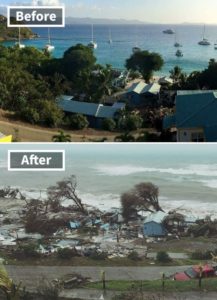Hurricane Irma’s Path of Destruction

Hurricane Irma caused widespread and catastrophic damage in Barbuda, Saint Barthélemy, Saint Martin, Anguilla and the Virgin Islands as a Category 5 hurricane. It caused at 84 deaths, including 45 in the Caribbean and 39 in the United States. For over a week, Irma’s intensity fluctuated between a Category 5 and 2 hurricanes. It was also the most intense Atlantic hurricane to strike the United States since Katrina in 2005.
All 1,800 residents of Barbuda have been evacuated to its sister island of Antigua after Hurricane Irma’s landfall on September 6 made Barbuda “uninhabitable” for the first time in 300 years. Downed phone lines ceased all communication with nearby islands-leaving the exact state of the island unclear for hours. Irma damaged or destroyed 95% of the structures on Barbuda with preliminary damage assessments of at least $150 million. Antigua sustained minimal damage with leveled roofs and fences, downed power poles lines, and uprooted trees. Some street flooding also took place in low-lying areas.
On September 6, Irma’s center crossed the island of Saint Martin with peak intensity, sweeping away entire structures, submerging roads and cars, triggering an island-wide blackout and killing 3 people. The majority of the island’s population was left stranded and without water, electricity or phone service. Premier William Marlin estimates between $1.2 – 1.5 billion in damage from Irma’s destruction.
Damage in the British Virgin Islands included buildings and roads destroyed on the island of Tortola, which bore the brunt of the hurricane’s core. Satellite images revealed many residential zones had been left in ruins on the island of Cane Garden Bay. Irma’s most severe damage were on the islands Saint Thomas and Saint John with 12 inches of rain fall and both island’s suffering widespread structural damage. Both islands had widespread power outages and three deaths were attributed to Irma.
Hurricane Irma reached the Turks and Caicos Islands on the evening of September 7th. While the eye passed just south of the main islands, crossing over South Caicos and the Ambergris Cays, the most powerful winds on the northern side of the eye swept all of the islands for more than two hours. Communications infrastructure was destroyed with extensive residential damage and some neighborhoods reported to be entirely gone. Minister of Infrastructure Goldray Ewing estimated that damage exceeding $500 million.
The eye of the storm passed over Duncan Town, in the Bahamas on September 8th and “almost directly over” Inagua and South Acklins. Damage was largely confined to the southern islands with downed power lines, lost communications, flooding and 70% of homes sustaining roof damage. Irma hit Cuba overnight September 8th as a Category 5 but weakened to a Category 3 hurricane on September 9th causing significant damage. Many one homes and roads were completely flooded with waves rolling through some towns. Irma is estimated to have caused at least $2.2 billion in damage and at least 10 deaths across the country.
Irma hit the Florida Keys on September 10th with reports at least 90% of structures in the Florida Keys suffering damage and a quarter of them were destroyed completely. Irma hit the Keys as a Category 4 storm causing major damage to nearly everything in its path, knocking out power, water, sanitation and communications. The hurricane was downgraded to Category 1, prior to reaching Tampa but still left nearly 4.5 million Florida residents without power for days. Damage along the length of the Keys, around Naples and Fort Myers area could reach as much as $300 billion, according to insurance analysts.



